Growing succulents in a medium that isn’t soil are possible, but it comes with several risks. Furthermore, having them grow without soil won’t allow this type of plant to last too long without it.
But, can succulents grow in rocks?
Yes, it can, but succulents are generally only grown using rocks and other materials, such as driftwood, for ornamental purposes. Growing them in rocks for gardening purpose isn’t a stable option for that matter.
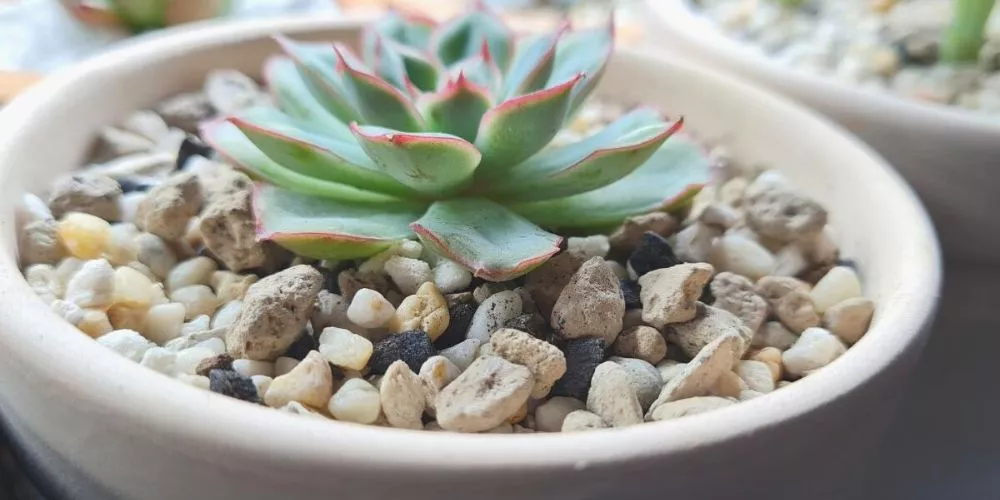
In saying that, it can be done, and that’s why we are here today! Let’s look at how to grow succulents using rocks and everything that should be understood about the process.
Table of Contents
Can succulents grow in rocks?
Succulents can grow in rocks or gravel, but the biggest problem is stability. The roots of any plant generally use their growing medium to establish themselves. They spread out and act as an anchor to support the weight of the plant above. Succulents are no different.
In their natural environment, these types of plants are generally found growing in a coarse, sandy, porous type of material. This sand enables their roots to also build strength via resistance.
Furthermore, the sandy material retains moisture and nutrients, making them available when required. Rocks make it much trickier to stabilize a succulent.
The roots can grow downwards and outwards but don’t have anything to attach to. They tend to slide around as the top weight sways the whole plant.
Also, rocks will not retain water, so nutrients also disperse due to runoff. If these issues can be addressed, a plant like this may survive, but it’s a lot of work for aesthetics.
Should succulents be in soil or rocks?
It’s been a hotly debated topic amongst succulent growers of late. There are, of course, many valid questions that are presented.
Is additional water necessary? Is it possible to grow them to maturity and beyond without soil? Does the fertilizer flush away much sooner?
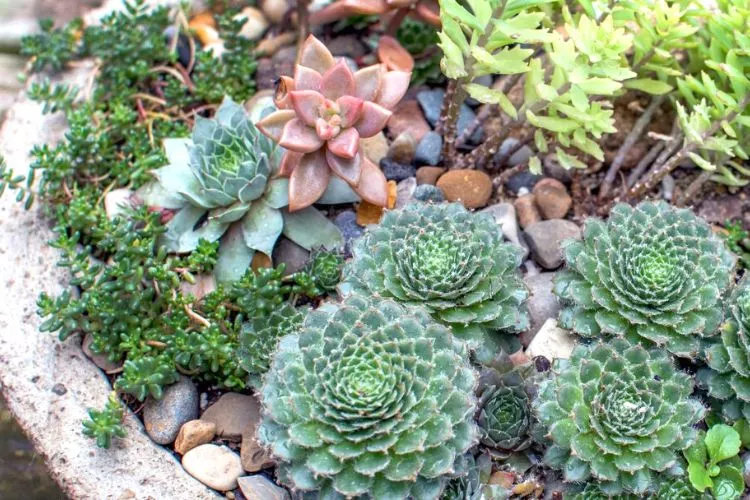
We must look at how succulents live in their natural environment to understand their needs when trying to mimic such a habitat.
There’s no denying that these plants can last long periods without water but not forever. The soil they are used to growing in provides stability and acts as a catchment system for both moisture and food to enable them to grow effectively.
Rocks, on the other hand, just don’t allow what the soil can offer but there is still hope for those who want to grow a succulent this way. In our opinion, succulents are best grown in soil but look great when arranged in rocks, so it’s tough.
Will succulents grow in gravel?
Using larger types of ‘growing material’ alone isn’t a good option for succulents. This includes rocks, gravel, and other natural and/or quarry-forged aggregates.
Succulents, like all plants, need water and nutrients to survive, and these materials just won’t retain them.
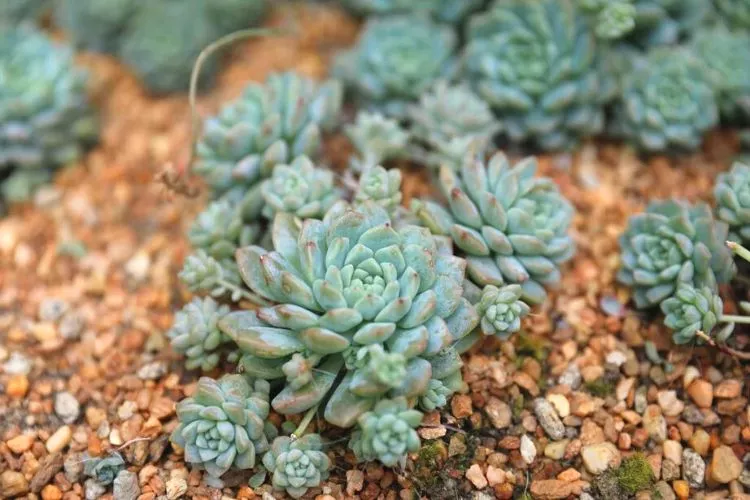
They will do the exact opposite. The water will drain away quickly and take all the nutrients with it. In contrast, gravel can be used in addition to a more traditional soil mix.
This way, the plant has its resistance or something to latch onto via the soil. It also retains vital moisture and plant food whilst, on the other hand, draining away any excess moisture.
What kind of rocks do you use for succulents?
When growing a succulent using only rocks as a medium, the main reason is aesthetics. As previously mentioned, rocks just can’t compete with soil regarding stability and moisture or nutrient retention.
However, if using rocks to arrange your succulents for an ornamental setting is what you’re after, look no further.
Often, growers keep the soil or another type of good quality growing medium down the bottom and use rocks or pebbles as a top dressing to complete a look of elegance.
The rocks can also prevent the plant from shifting around above the soil.
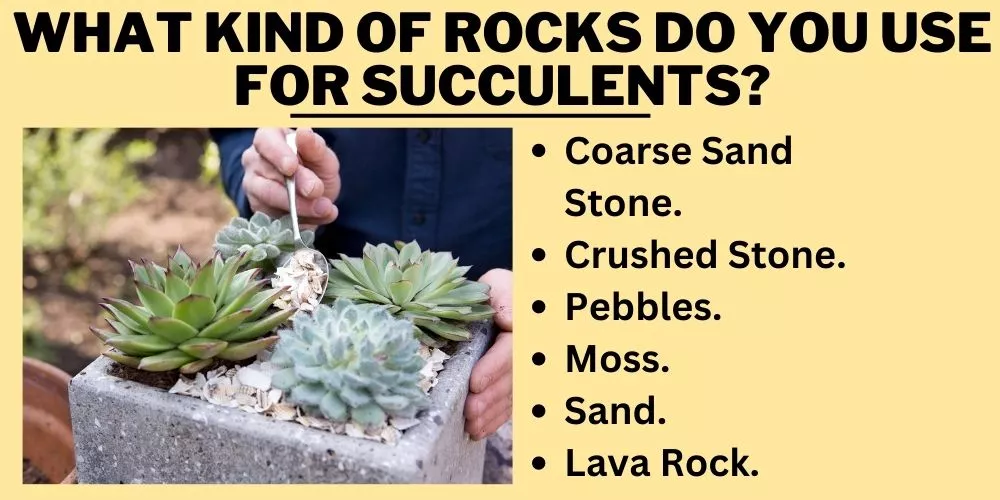
There is an extremely wide range of types, sizes, shapes and colors. Let’s look at some of the most common materials and methods used when arranging succulents in a base created with rock.
Coarse Sand Stone
Coarse sandstone offers stability, aeration and adequate drainage. This type of rock is generally perfect in between sizes. This enables growers to set it in place without damaging materials such as sand.
It can be used independently or as a gap filler between larger stones/pebbles. The sandy color helps other shades to pop out when placed correctly.
Crushed Stone
Crushed stone can be purchased in various sizes, shapes and colors. Its usage comes down to personal preference. Some growers prefer to use these stones on their own as they are rather easy to place and keep maintained.
You could purchase different sizes with different colors and build layers from the inside of the pot to the outer edges for a uniform look.
Pebbles
As with crushed stone, pebbles also come with a massive range to suit all succulent types. The most common type is beach pebbles. Blacks and whites with altering tones can make a simple arrangement look extravagant.
Furthermore, pebbles have amazing drainage capabilities. They are generally much bigger, enabling moisture to easily penetrate the top layer. This is great for avoiding mess caused by splashing.
Moss
We added moss here due to its availability and inexpensive price tag. Of course, it’s not a rock, but it can serve a purpose and looks great when properly arranged. Moss works well because it is super absorbent. Meaning it can retain water, unlike rocks and pebbles.
We have found that mixing moss and larger beach pebbles helps each other retain water, drain water and look great. It sounds counterproductive, but the combination shouldn’t be knocked down until it’s tried. Moss comes in many different colors and textures. It can be easily torn or cut and sized to suit the arrangement.
Sand
Sand is a wild card, especially the more coarse types. This type of material comes in a few different colors. It adds an extra dimension when used in combination with sandstone.
It can make the sandstone pop a little bit more. Sand also acts as a medium level drainage material. It doesn’t allow moisture to gush away like the larger rocks, but it allows water to move around freely.
Lava Rock
Lava rock is a little more pricey but slightly extra extravagant, which justifies its price tag. This material brings an earthy vibe with its darker colors and jagged, uneven edges.
Lava contains high levels of iron, magnesium, nitrogen and other minerals, which assist in succulent growth.
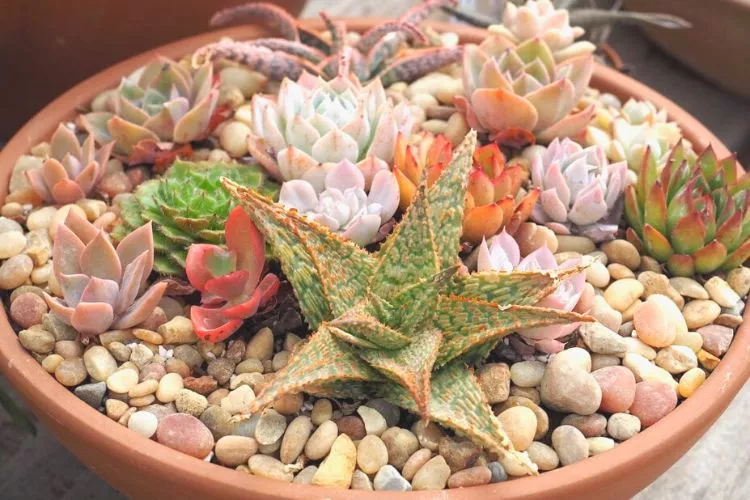
Keep in mind that whatever rock type you choose, some extra steps may be needed to prepare them before use. This could include washing or preparing them in a certain way. Share some ideas about decorating succulents with rocks, and if possible, create a subheading for each idea you are writing.
How do you plant succulents with rocks and soil?
Rocks alone aren’t the best materials to use when growing succulents. They will make it extremely difficult just to keep them alive.
On the other hand, combining soil with rocks is the perfect combination. You can plant the succulents as normal into the soil and leave enough space to place rocks for an elegant finish.
The hardest part is leaving enough space between the top of the soil and underneath the succulent lower leaves to place the rocky material. Let’s go through a scenario to demonstrate the simplest way to plant succulents using soil and rocks.
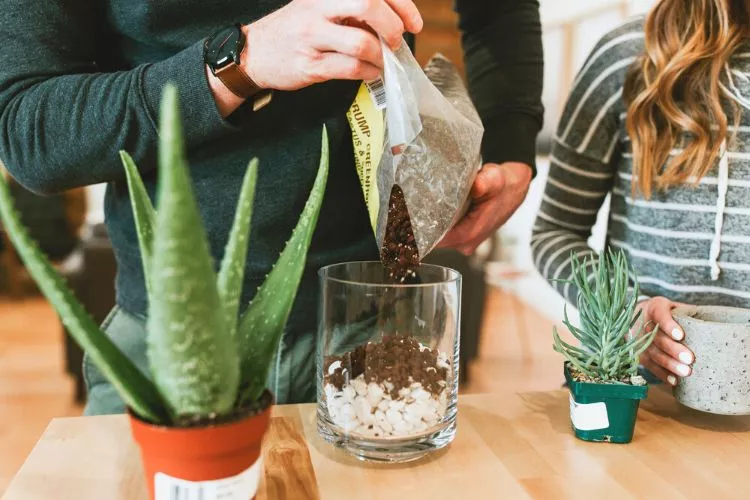
It’s worth noting that different species of succulents have different growing patterns and requirements that aren’t the same as other variants.
What you will need
- Growing container or place in a garden
- DIY 3 parts succulent soil: 2 parts coarse sand (turface or poultry grit) & 1 part perlite (or pumice)
- Your choice of rock (coarse sandstone, crushed stone, pebbles, sand, lava rock, etc.)
- Your choice of succulent plant
- Small gardening tools (spade, fork, etc.)
- Watering can or soft head hose, including water source
The Process
- Prepare an area in your garden by digging a few inches larger than the diameter of the root ball of your succulent plant. If growing in a pot, skip this part.
- Add some DIY succulent soil to either the newly dug area in your garden or the pot/container you wish to plant in. When adding to the garden, fill around the edges to surround the succulent with nutrients once planted; when adding to a pot, size up the root ball and add soil until you can sit the succulent comfortably. You want it to look right when poking out the top of the pot. Leave enough space to place your rocks above the soil but below the succulents’ lower leaves.
- Gently place the succulent into the soil. Make sure that it is standing upright and stable. Add some more soil around the sides and top. Gently pack the plant into place to stabilize it.
- Give it some water before adding rocks to the arrangement. Ensure that it is moist but not soaking.
- Proceed to add rocks around the base of the succulent. Aim to slope it a little from the stem out toward the edges of the pot. It’s up to you to arrange them with color, size and placement. Everyone has their different tastes when it comes to arrangements.
Succulents don’t need a ridiculous amount of water. They can usually retain moisture within their leaves and stems for periods. When watering, only give them what they need, without overwatering. Always water at the base and avoid watering from above.
This can cause the leaves to burn. Succulents don’t usually require too much fertilizer but can benefit from smaller amounts of plant food from mid spring to the end of summer.
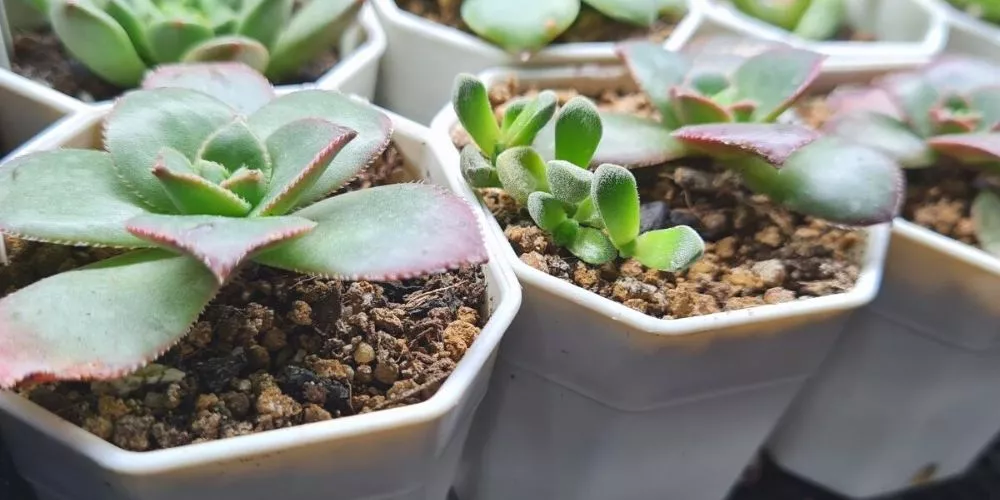
They can become dormant in the winter and not take in any nutrients, leaving them sitting there and toxifying the soil. So avoid feeding in winter. Avoid placing them in extreme heat and chilled environments.
Frequently Asked Questions (FAQs)
Is it OK to put rocks around succulents?
It is ok to arrange rocks around succulents. In fact, not only do they look great, they can add some much needed nutrients to the soil that they wouldn’t otherwise receive. Of course, this all depends on the type of rocks used. It’s worth noting that rocks shouldn’t be used as a stand alone material. They are best used as a topping layer.
What is best to plant succulents in?
Succulents thrive best in a well draining, sandy soil blend that can assist with aeration. Creating your own with a few easily obtainable ingredients is extremely simple. For a 3 part succulent soil mix, add 2 parts coarse sand (turface or poultry grit) & 1 part perlite (or pumice). Mix them up and use them as normal.
Why put pebbles on succulents?
Darker shaded pebbles have the handy ability to heat up, which can assist the plant in a few ways. Firstly, it heats the soil, keeping colder temperatures away for longer. Furthermore, the heat that it produces encourages root development.
In contrast, lighter pebbles can help reflect heat. They are more suited to warmer climates. Adding pebbles as a dress layer also deflects and prevents heavy watering from destroying the top of the soil.
Conclusion
So as we can see, succulents can grow in rocks but not rocks alone. They are better suited as a top dressing layer. This top layer can help deflect water and absorb heat to assist with root development don’t forget how amazing some arrangements can look.
We hope this article has been helpful, and we look forward to creating more to help you on your green thumb journey. As always, happy growing!


